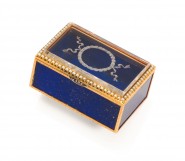Lot #27 - Arthur Boyd
-
Auction House:Mossgreen
-
Sale Name:The Contents of Prince Albert House, Mosman
-
Sale Date:21 Aug 2016 ~ 2pm
-
Lot #:27
-
Lot Description:Arthur Boyd
(1920-1999)
Potter and Wife in a Field with Cow circa 1969
oil on canvas
107 x 225 cm
signed lower right: Arthur Boyd -
Provenance:Private Collection; Christies, Australian and European Paintings, Drawings and Prints, Part I and II, Melbourne, 29 April 1997, Lot 76
-
Notes:Potter and Wife in a Field with Cow belongs to a small but important group of paintings we call the Potter series. It represents a number of the key iconographic, autobiographic and thematic characteristics central to the art of Arthur Boyd. For one, the present work demonstrates that although Boyd was far from Murrumbeena and his adolescent years, the seminal visions - and dreams, perhaps - lingered with persistence in his work.1 He had been living in London for over a decade, yet he insisted that England was only his 'base', not his 'home'.2 By painting the Potter Series and other Australian-themed subjects, Arthur Boyd, in the words of one critic, was reliving 'the places and images of the past. In a snow-bound studio he has envisioned the desert; in a garden of ash and maple trees, he has painted gum and wattle; in freezing winter winds, he has painted bush-fires.'3 In fact, 'his identity', wrote art historian Janet McKenzie, 'remained firmly Australian ... - spiritually and intellectually an inhabitant of Australia.'4 Of course, there were also commercial demands steering his art; these generally dictated that Australian pictures were intrinsically, or fashionably, more popular and easier to sell than works set in Suffolk or Europe. In any case, working on Australian memory-scapes of his childhood and his familial relationships offered Boyd, in a self-psychoanalytical sense, the possibility to revisit, remember and rehabilitate the dualities of love and trauma which his parents represented. In this respect, the present work is an important symbolic and personal picture. The artist's parents, Merric and Doris Boyd, were important figures for Arthur's artistic and moral development. Until their deaths in 1959 and 1960, respectively, they were exemplars of chaste love, religious austerity, artistic freedom, and through Merric's long battle with epilepsy, the fragility of a stable life. Ten years had passed since their deaths, and they are here shown on the right as faint ghostly figures with little mass or weight to them. While Merric is shown in his Australian Flying Corps uniform (he had served in the First World War), Doris, is disembodied, shown from the neck up and resting on Merric's shoulder in a sign of guidance and companionship. They have their heads bowed in an almost shameful slump, recalling the traditional iconography often associated with the representation of Adam and Eve and their banishment. Indeed, the two figures are shown leaving the confines of their Eden, here represented by a bushy backdrop, and walk into the dry and barren wilderness which they are now in. Boyd had already explored the theme in The Expulsion, 1947-8 (Art Gallery of New South Wales, Sydney), but is revisiting it here in a less overtly religious context. The presence of the cow in the present work could be seen, as it often is, as a disquieting observer or intruder. Boyd himself said that his 'lovers ... suffer from being unprivate, watched. Love becomes guilt because it is frustrated. Pictures with an animal or another human figure watching lovers are intended to give the idea of spying, a disturbance, a breaking into the moment of privacy.'5 Again, Boyd reinforces the guilt and shame which so distinctly characterise Adam and Eve. However, there is another possible reading of this composition. In discussing Boyd's philosophical perspectives, Bernard Smith described how, 'Boyd sees life as an endless movement between the material and the spiritual, that is to say cyclic.'6 If we are to apply this Smith's framework to the analysis of this painting, we instantly recognise that this work is about the cycle of life and death. Indeed, the cow is not even aware of the presence of the two figures, nor are they of the cow. Its bloated udder and bloody tail suggest that the animal is perhaps in labour, a symbolic reminder that life will follow death, will follow life. In essence, this was a deeply personal work for Boyd. And one cannot help but imagine that the whole series was, after all, a therapeutic ode to his forebears; an exegesis of Merric and Doris Boyd, through the lens of the Old Testament. Petrit Abazi 1 Boyd actually visits Australia in 1968, re-igniting his interest in his childhood and country. This short sojourn in Australia probably ignited his memories and images of the past; 2 Peter Smark, 'A recharge for Boyd's batteries', The Sunday Australian, 14 March 1971, p. 17; 3 Sandra McGrath, 'Boyd: still the master', Australian, 12 March 1980; 4 Janet McKenzie, Arthur Boyd: art & life, Thames and Hudson, London, 2000, p. 18; 5 Cited in Grazia Gunn, Arthur Boyd: seven persistent images, Australian National Gallery, Canberra, 1985, pp. 59-60; 6 Bernard Smith, 'Art in a mystical tradition', Hemisphere: An Asian-Australian Monthly, Commonwealth Office of Education, Sydney, April 1972, p. 19
-
Estimate:A$70,000 - 90,000
-
Realised Price:
-
Category:Art
This Sale has been held and this item is no longer available. Details are provided for information purposes only.










